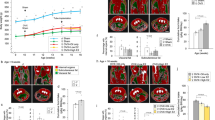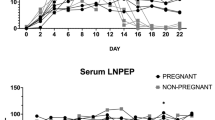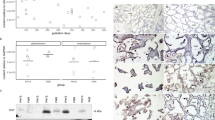Abstract
Oxytocin is a nonapeptide hormone produced by the hypothalamus and released from the posterior pituitary. It is cleaved from a large molecular weight precursor which is synthesized in cell bodies of hypothalamic magnocellular neurones and then packaged into membrane-bound granules1. During axonal transport the precursor is cleaved to produce oxytocin and an oxytocin-related neurophysin. Apart from its established roles in lactation and labour, oxytocin is thought to be an important regulator of the oestrous cycle; it causes luteolysis in cattle2 and immunization against oxytocin increases the length of the ovine oestrous cycle3, McCracken4 has proposed that oxytocin acts by stimulating prostaglandin F2α (PGF2α) release from the uterine endometrium and that steroid hormones regulate PGF2α secretion by altering the availability of endometrial oxytocin receptors4,5. Steriods may also have a direct influence on oxytocin release from the posterior pituitary, oestradiol-17β increasing and progesterone inhibiting oxytocin secretion in response to vaginal distension in the goat6,7. However, recent radioimmunoassay (RIA) measurements of peripheral oxytocin levels during the ovine oestrous cycle8–10 consistently show that oxytocin and progesterone concentrations increase and decrease in synchrony during the luteal phase, reaching basal levels after luteolysis at a time when oestradiol-17β titres are known to rise11. Therefore, there may exist different controls of reflex release and basal secretion of oxytocin, and our discovery of large amounts of oxytocin within the ovine corpus luteum reported here may provide an explanation.
This is a preview of subscription content, access via your institution
Access options
Subscribe to this journal
Receive 51 print issues and online access
$199.00 per year
only $3.90 per issue
Buy this article
- Purchase on Springer Link
- Instant access to full article PDF
Prices may be subject to local taxes which are calculated during checkout
Similar content being viewed by others
References
Pickering, B. T. Essays Biochem. 14, 45–81 (1978).
Armstrong, D. T. & Hansel, W. J. Dairy Sci. 42, 533–542 (1959).
Sheldrick, E. L., Mitchell, M. D. & Flint, A. P. F. J. Reprod. Pert. 59, 37–42 (1980).
McCracken, J. A. Adv. Prostaglandin Thromb. Res. 8, 1329–1344 (1980).
Roberts, J. S., McCracken, J. A., Gavagan, J. E. & Soloff, M. S. Endocrinology 99, 1107–1114 (1976).
Roberts, J. S. Endocrinology 89, 1029–1033 (1971).
Roberts, J. S. Endocrinology 89, 1137–1141 (1971).
Webb, R., Mitchell, M. D., Falconer, J. & Robinson, J. S. Prostaglandins 22, 443–453 (1981).
Sheldrick, E. L. & Flint, A. P. F. Prostaglandins 22, 631–636 (1981).
Schams, D., Lahlou-Kassi, A. & Glatzel, P. J. Endocr. 92, 9–13 (1982).
Baird, D. T. & Scaramuzzi, R. J. J. Endocr. 70, 237–245 (1976).
Walsh, J. R. & Niall, H. D. Endocrinology 107, 1258–1260 (1980).
Fields, M. J., Fields, P. A., Castro-Hernandez, A. & Larkin, L. H. Endocrinology 107, 869–876 (1980).
Lederis, K. Gen. comp. Endocr. 1, 80–89 (1961).
Neher, G. M. & Zarrow, M. X. J. Endocr. 11, 323–330 (1954).
Fylling, P. Acta. endocr. 65, 273–283 (1970).
Gemmel, R. T., Stacey, B. D. & Thorburn, G. D. Biol. Reprod. 11, 447–462 (1974).
Paavola, L. G. & Christensen, A. K. Biol. Reprod. 25, 203–215 (1981).
Gemmel, R. T. & Stacy, B. D. Am. J. Anat. 155, 1–14 (1979).
Quirk, S. J., Wilcox, D. L., Parry, D. M. & Thorburn, G. D. Biol. Reprod. 20, 1133–1145 (1979).
Kendall, J. Z., Plopper, C. G. & Bryant-Greenwood, G. D. Biol. Reprod. 18, 94–98 (1978).
Anderson, M. L. & Long, J. A. Biol. Reprod. 18, 110–117 (1978).
Baird, D. T., Land, R. B., Scaramuzzi, R. J. & Wheeler, A. G. J. Endocr. 69, 275–286 (1976).
Sofroniew, M. V., Madler, M., Müller, O. A. & Scriba, P. C. Z. analyt. Chem. 290, 163 (1978).
Author information
Authors and Affiliations
Rights and permissions
About this article
Cite this article
Wathes, D., Swann, R. Is oxytocin an ovarian hormone?. Nature 297, 225–227 (1982). https://doi.org/10.1038/297225a0
Received:
Accepted:
Issue Date:
DOI: https://doi.org/10.1038/297225a0
This article is cited by
-
Seasonal Expression of Oxytocin and Oxytocin Receptor in the Scented Gland of Male Muskrat (Ondatra zibethicus)
Scientific Reports (2017)
-
Immunocytochemical localization of oxytocin in corpora lutea and luteinized cysts from anoestrous ewes stimulated with gonadotrophin-releasing hormone
Cell and Tissue Research (1990)
-
The neuroendocrine thymus
Histochemistry (1988)
Comments
By submitting a comment you agree to abide by our Terms and Community Guidelines. If you find something abusive or that does not comply with our terms or guidelines please flag it as inappropriate.



